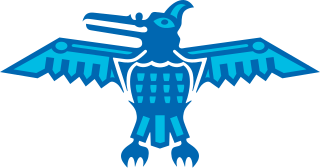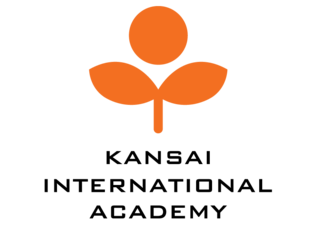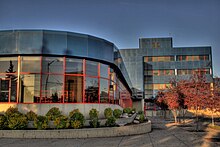
Language immersion, or simply immersion, is a technique used in bilingual language education in which two languages are used for instruction in a variety of topics, including math, science, or social studies. The languages used for instruction are referred to as the L1 and the L2 for each student, with L1 being the student's native language and L2 being the second language to be acquired through immersion programs and techniques. There are different types of language immersion that depend on the age of the students, the classtime spent in L2, the subjects that are taught, and the level of participation by the speakers of L1.
This is an index of education articles.

French immersion is a form of bilingual education in which students who do not speak French as a first language will receive instruction in French. In most French-immersion schools, students will learn to speak French and learn most subjects such as history, music, geography, art, physical education and science in French.

Old Strathcona Academic, often referred to as Old Scona or OSA, is a high school in the Old Strathcona district of Edmonton, Alberta. It is a small academic high school with a population of approximately 340 to 360 students. The school's stated purpose is to provide academically inclined students an opportunity to grow in an environment of intellectual stimulation, and is recognized as one of the top academic high schools in Canada. The school's motto is, "Ever to Excel".
Bilingual–Bicultural or Bi-Bi deaf education programs use sign language as the native, or first, language of Deaf children. In the United States, for example, Bi-Bi proponents state that American Sign Language (ASL) should be the natural first language for deaf children in the United States, although the majority of deaf and hard of hearing being born to hearing parents. In this same vein, the spoken or written language used by the majority of the population is viewed as a secondary language to be acquired either after or at the same time as the native language.
English-language learner is a term used in some English-speaking countries such as the United States and Canada to describe a person who is learning the English language and has a native language that is not English. Some educational advocates, especially in the United States, classify these students as non-native English speakers or emergent bilinguals. Various other terms are also used to refer to students who are not proficient in English, such as English as a second language (ESL), English as an additional language (EAL), limited English proficient (LEP), culturally and linguistically diverse (CLD), non-native English speaker, bilingual students, heritage language, emergent bilingual, and language-minority students. The legal term that is used in federal legislation is 'limited English proficient'. The instruction and assessment of students, their cultural background, and the attitudes of classroom teachers towards ELLs have all been found to be factors in the achievement of these students. Several methods have been suggested to effectively teach ELLs, including integrating their home cultures into the classroom, involving them in language-appropriate content-area instruction early on, and integrating literature into their learning programs.
Dual language is a form of education in which students are taught literacy and content in two languages. Most dual language programs in the United States teach in English and Spanish, but programs increasingly use a partner language other than Spanish, such as Arabic, Chinese, French, Hawaiian, Japanese, or Korean. Dual language programs use the partner language for at least half of the instructional day in the elementary years.
Emotional and behavioral disorders refer to a disability classification used in educational settings that allows educational institutions to provide special education and related services to students who have displayed poor social and/or academic progress.

Victoria School of the Arts is a public school in Edmonton, Alberta, Canada operated by Edmonton Public Schools, offering students from kindergarten through grade 12 an International Baccalaureate aligned, arts-focused education, and is recognized as one of the top arts-focused schools in North America.

Ross Sheppard High School or École Ross Sheppard is a high school located in a northwest neighbourhood of Coronation Park, in Edmonton, Alberta, Canada. The school colours are Colombia blue and navy blue, and it is represented by a Thunderbird, also known as a T-Bird logo. Outside the school is a totem pole with a T-Bird on top, which has been given by British Columbia's Indigenous elders, representing the school mascot. The school serves the needs of over 2,000 students attending grades 10-12, including approximately 35 international students annually. Ross Sheppard School's philosophy is based on four pillars - Academics, Arts, Athletics and Service.

Learning disability, learning disorder, or learning difficulty is a condition in the brain that causes difficulties comprehending or processing information and can be caused by several different factors. Given the "difficulty learning in a typical manner", this does not exclude the ability to learn in a different manner. Therefore, some people can be more accurately described as having a "learning difference", thus avoiding any misconception of being disabled with a possible lack of an ability to learn and possible negative stereotyping. In the United Kingdom, the term "learning disability" generally refers to an intellectual disability, while conditions such as dyslexia and dyspraxia are usually referred to as "learning difficulties".
Bev Facey Community High School, known as Bev Facey, is a public high school for grades 10–12 in Sherwood Park, Strathcona County, Alberta, which falls under the jurisdiction of the Elk Island Public Schools Regional Division No. 14.
Millwoods Christian School, located in southeast Edmonton, Alberta, Canada, is an alternative school in the Edmonton Public School System.
Louis St. Laurent Catholic School is a fine arts oriented Junior and Senior High School in the Edmonton Catholic School District, located in south western Edmonton. It is also known as "Louis" or "LSL" by students and staff. The school averages a student body of approximately 1,000 or more pupils each year, spanning grades 7 through 12. From 2009 to 2022, the entire school participated in the International Baccalaureate program. As of 2016, a few students participate in the Spanish bilingual program. As of 2021, the school incorporates the Advanced Placement curriculum. In 2022, Spark Academy was introduced.

Uruguayan American School (UAS) is an American private international school in Carrasco, Montevideo. It serves nursery through grade 12. As of 2024 it has approximately 350 students, including students from Uruguay and 32 other nationalities. Students at the Uruguayan American School have the opportunity to earn the US high school diploma, the IB Diploma, and, in many cases, the Uruguayan Diploma. The school's educational program is designed to prepare students for academic and professional pursuits in various global contexts.
Edmonton Chinese Bilingual Education Association (ECBEA) is a non-profit educational organization working to promote the learning of the Chinese language alongside the regular school curriculum through a bilingual education program in Edmonton, Alberta, Canada. The program is unique in North America as it exists alongside the regular school curriculum and offers a complete continuum of studies from Kindergarten all the way to High School graduation. The society works in close association with the Edmonton Public Schools.

In the United States, elementary schools are the main point of delivery of primary education, for children between the ages of 4–11 and coming between pre-kindergarten and secondary education.
The Ukrainian Bilingual Program (UBP) is part of some Albertan school board's education. The program was introduced in Edmonton in both the secular and Catholic systems After initially being in Edmonton it then expanded to Vegreville in 1978, Sherwood Park] in 1979 and Lamont 1980. Ukrainian as a second language has been taught as 9-year, 6-year and 3-year long programm in rural Alberta. There was also a locally developed program from grade 1 in the County of Two Hills.
M.E. LaZerte High School is a high school in Edmonton, Alberta, Canada in the north eastern Kilkenny neighbourhood. It is part of Edmonton Public Schools. The school's team name is the Voyageurs, which is also what they call the student body.

Kansai International Academy is a private group of international schools pre-K through grade 9 in Japan, they are Kansai International School and Sakura International School.









